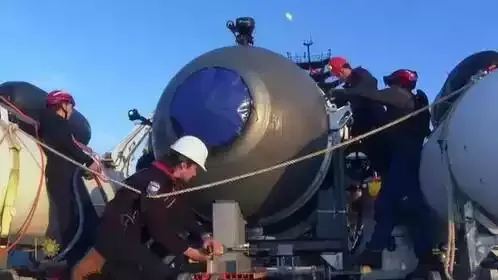We recognize the deep-seated problem surrounding the whereabouts of the Titanic submersible and the nicely-being of its five team individuals. The situation is nothing short of harrowing, with the looming threat of oxygen depletion adding to the gravity of the race against time. However, it is crucial to recognize that the timeline for oxygen availability may be more flexible than initially perceived. In this article, we delve into the intricacies of the conditions onboard the submersible and shed light on why the oxygen timeline is subject to variations.
A Multifaceted Experience: Differing Conditions Person-to-Person
To comprehend the dynamic nature of oxygen depletion within the Titanic submersible, it is essential to acknowledge that conditions aboard can be experienced differently from person to person. Dr. Ken LeDez, an esteemed hyperbaric medicine expert at Memorial University, highlights this critical aspect. While the situation within the submersible remains uncertain, Dr. LeDez emphasizes the potential variation in individual circumstances and survival prospects. Although acknowledging the discomforting nature of this discussion, he brings forth the notion that certain crew members might endure longer than others.
For more detail read, you can visit this site. Click here.
The Gradual Process of Oxygen Depletion
Contrary to popular belief, the depletion of oxygen within the submersible is not akin to the short flick of a switch. Rather, it manifests as a gradual process comparable to ascending a mountain as the temperature drops and metabolism slows down. Dr. LeDez aptly illustrates this analogy, emphasizing the interplay between decreasing temperatures, falling metabolism, and the ascent up the metaphorical mountain. This intricacy highlights the significance of external factors, such as cold exposure and oxygen conservation measures, in determining survival duration.
Beyond Oxygen Depletion: Additional Hazards Onboard
While the dwindling oxygen supply remains a pressing concern, it is vital to recognize that the crew faces other imminent dangers within the submersible. One such hazard is the capability loss of electrical electricity, essential to keep oxygen and carbon dioxide levels. The proportion of carbon dioxide inhaled increases as oxygen levels drop, potentially having deadly effects. The buildup of carbon dioxide inside the blood, called hypercapnia, can be fatal if left untreated.
Former Royal Navy submarine captain Ryan Ramsey highlights the absence of a carbon dioxide removal system, or scrubbers, within the submersible. This absence amplifies the risks associated with carbon dioxide buildup, further compounding the precarious situation. The crew is thus confronted with a multifaceted challenge that encompasses oxygen depletion, carbon dioxide accumulation, and the absence of vital life-support systems.
For more detail read, you can visit this site. Click here.
Hypothermia: A Double-Edged Sword
In the face of the crew's predicament, the risk of hypothermia emerges as both a potential ally and adversary. With water temperatures likely hovering around freezing if the submersible is on the seabed, the crew is exposed to extreme cold without electricity to generate heat. Yet, Dr. LeDez posits that hypothermia could paradoxically enhance their chances of survival. He explains that if the crew members cool down to the point of losing consciousness, they might endure the ordeal as the body's instinctual response to adapt kicks in. This adaptive mechanism represents a glimmer of hope amidst their myriad challenges.
However, low temperatures present unique problems. The team's potential to speak with search and rescue operations is hindered by low temperatures, oxygen loss, and carbon dioxide buildup. Impaired cognitive and motor functions resulting from unconsciousness render them unable to proactively signal for assistance. The interplay between these factors underscores the urgent need for a comprehensive rescue effort while considering the crew's endurance and resilience.
Resource Conservation: A Tenuous Balance
Despite the formidable obstacles confronting the crew, there may be opportunities to conserve vital resources, at least for a limited period. Slowing down their breathing and reducing power consumption represent potential strategies to extend the lifespan of the available oxygen. While acknowledging the inherent challenges associated with such measures, experts assert that these conservation efforts might buy valuable time amidst the critical situation.
Regarding sustenance, the crew reportedly possesses limited rations, the exact quantity of which remains to be discovered. The crew's capacity to withstand the physical and mental strain they must suffer is equally important to consider as the availability of food and water for survival. They see resilience, resourcefulness, and flexibility as crucial traits that may be crucial to their survival.
For more detail read, you can visit this site. Click here.
The Unyielding Will to Live
In the face of an immensely challenging predicament, it is crucial not to prematurely dismiss the possibility of survival. Rear Admiral John Mauger of the US Coast Guard underscores the importance of accounting for the crew members' indomitable will to live, particularly in complex cases. Dr. LeDez echoes this sentiment, expressing his belief that if anyone possesses the tenacity to survive, it is these remarkable individuals. While reliant on the availability of power and light to navigate their surroundings and operate essential controls, their resilience, and determination cannot be underestimated.
Conclusion
The uncertainties surrounding the Titanic submersible and its crew evoke a profound sense of concern and urgency. The timing for oxygen depletion needs to be defined as we learn more about the intricacies of oxygen levels and the many difficulties they encounter. A thorough grasp of the issue is necessary due to the variable conditions from person to person, the progressive nature of oxygen loss, and the interconnected dangers of carbon dioxide buildup and hypothermia. While conserving vital resources and acknowledging the crew's resilience, it is imperative to maintain an unwavering commitment to the search and rescue operation. We must keep looking for hidden tales of survival that may exist in the incomprehensible depths of the ocean.
FAQs
Q: What is the current situation with the crew and the submersible Titanic?
A: The five crew members' conditions and the precise location of the Titanic submarine are now unclear.
Q: Why is the timeline for oxygen depletion not fixed?
A: Oxygen depletion is a gradual process that can vary depending on temperature, metabolism, and oxygen conservation measures. Different individuals may experience varying conditions and survival prospects.
Q: What are the dangers of carbon dioxide buildup in submerged water?
A: The proportion of inhaled carbon dioxide rises as oxygen stages fall. If left untreated, excessive carbon dioxide tiers should have a lethal sedative impact that can cause coma or even death.
Q: Does the Titanic submarine have a device to remove carbon dioxide (scrubbers)?
A: Ryan Ramsey, a former captain of a Royal Navy submarine, claims that the absence of a visible carbon dioxide removal system on the submersible increases the dangers of carbon dioxide buildup.
Q: What are the crew's odds of surviving hypothermia?
A: Hypothermia has possible advantages as well as hazards. Although extremely low temperatures can be harmful, if the crew freezes to become unconscious, their systems may naturally adapt to help them live. However, they are also less able to connect with a rescue mission.
Q: Can the crew conserve oxygen and extend their survival time?
A: The crew may conserve their oxygen supplies for a limited period by reducing power consumption, slowing their breathing, or using carbon dioxide-absorbing granules. However, these measures can be challenging given the stressful circumstances.
Q: How much water and food are available to the personnel onboard?
A: While it has been discovered that the team has a few " limited rations" on board, it is still being determined precisely how great deal meals they've.
Q: Should the quest and rescue effort pass on despite the problems?
A: The importance of delaying the search and rescue effort is emphasized by experts. The crew should be considered even when oxygen levels are low since they may still have a chance of living.
Free Image Converter | Any Image Format Converter | Online & Free
Unveiling the Impact of Human Activities on Earth's Axis
Steam Next Fest Launches Today, Offering Access To 100s Of Game Demos
Want to See These Galaxy Z Fold 5 Features
The Future of Cloud Gaming & its Effect on the Gaming Community
Impact of New Streaming Services on the Entertainment Industry
Social Video Takes Off: Leverage the Power of Video Marketing










